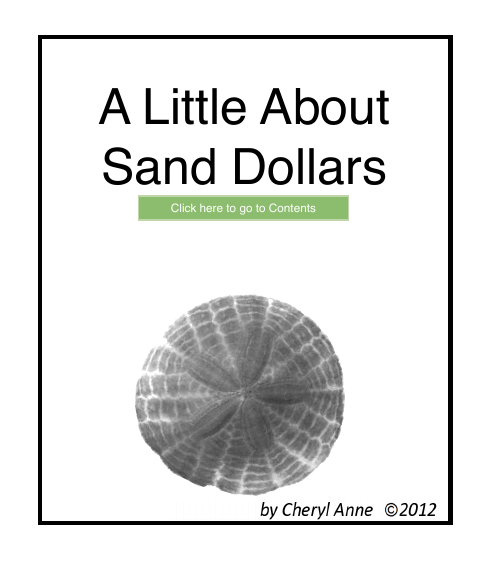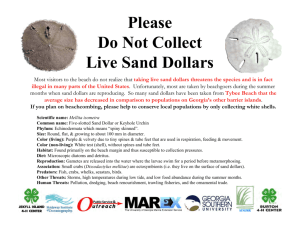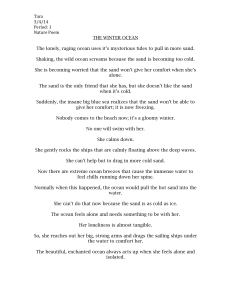
A Little About
Sand Dollars
Click here to go to Contents
a Rock Bottom Designs publication © 2004
Contents
- Click on topic to go there -
What Are Sand Dollars? . . . . . . . . . . . . . . . . 1
Where Do Sand Dollars Live? . . . . . . . . . . . . 2
What Do Sand Dollars Eat? . . . . . . . . . . . . . . 3
How Do They Eat? . . . . . . . . . . . . . . . . . . . . 3
How Do Sand Dollars Breathe? . . . . . . . . . . . . . 4
What Are They Related To? . . . . . . . . . . . . . . 4
How Do Sand Dollars Move? . . . . . . . . . . . . 5
Do Sand Dollars Have Enemies? . . . . . . . . . 5
How Do Sand Dollars Multiply? . . . . . . . . . . . 6
What Do Sand Dollars Do? . . . . . . . . . . . . . . 7
How Do You Find Sand Dollars? . . . . . . . . . . . 7
Is It Still Alive? . . . . . . . . . . . . . . . . . . . . 8
How Do You Clean Sand Dollars? . . . . . . . . 8
What Do You Do With Them? . . . . . . . . . . . . . 9
Glossary . . . . . . . . . . . . . . . . . . . . . . . . . .10
What Are Sand Dollars?
Sand dollars are creatures that belong to the class Echinoidea. They are bilaterally symmetrical so they are known as
‘irregular echinoids’. That means that they have a front end
that always faces the direction they are traveling. Sand dollars are Echinoderms because echinoderm means ‘spiny
skin’, and the ‘fur’ of a sand dollar is composed of tiny spines.
Sand dollars are a deep chocolatey maroon color, and the
spines have a coarse velvety feel.
The skeleton of a sand dollar is made of
calcium carbonate plates. Sand dollars
are often uprooted and killed by storms.
Ca
Usually, by the time they are found on
Formula: CCa0 3
the beach, sand and waves have rubbed
the spines off; the remaining shell is called a test.
Calcium
Carbonate
Molecule
+2
The oldest sand dollar fossil, named Arkarua, lived in the
oceans off Australia about 560 million years ago during the
Earth’s Pre-Cambrian Age.
1
Click here to return to Contents
Where Do Sand Dollars Live?
Sand dollars live and travel in the sand in the intertidal and
subtidal zones of Earth’s oceans. They live in both temperate
and tropical waters where the water is shallow. Most species
live in water up to about 40 feet deep, but some can be found
as deep as a mile. Living in large gatherings, they like sheltered areas with soft sandy floors and gentle tides.
They travel just beneath the surface of the
sand. During storms, they lie flat and burrow
a little deeper, but when the water is calm,
they like to stand on end, waving lazily to and
fro with the ocean’s currents.
The most common species living along the
west coast from Alaska to California is
called Dendraster Excentricus.
2
Click here to return to Contents
What Do Sand Dollars Eat?
Sand dollars eat plankton, copepods, and tiny plants called
diatoms. These live in the ocean’s currents or cling to grains
of sand. When the sea bed is calm, sand dollars stand on end
with their oral surfaces facing the current, letting the ocean
bring food right into their mouths. When water is rougher,
they stay beneath the sand’s surface and ingest sand and
water from the ocean floor. This is called ‘bulk-processing’.
How Do They Eat?
Sand dollars eat with their feet! As they move through the
sand, food is trapped among the spines. Covering the spines
are fine hairs called cilia, and these
Food
Mouth Grooves
transport food to specialized tube
feet called podia that line the
Periproct
creature’s food grooves. These
podia transport food along the food
grooves to its mouth, called its peristome, where
food and sand are crushed between strong teeth
by muscles called Aristotle’s Lantern.
Aristotle’s Lantern
Click here to return to Contents
How Do Sand Dollars Breathe?
Sand dollars breathe through their feet, of course! Not the
same feet though! These specialized
tube feet grow out of the holes that
create the petaloids on the creature’s top, aboral, surface. Tube
feet pull water into its water vascular system where carbon dioxide is exchanged for oxygen and
circulated throughout its body.
What Are They Related To?
Sand dollars, like sea stars, sea urchins, and sea cucumbers,
are a member of the phylum echinodermata. These creatures
are characterized by having ‘spiny skin’ and
being pentameral - the sand dollar’s five
petals, the five arms of the star fish,
and the five rays of the sea urchin.
4
Sea Urchin test
Click here to return to Contents
How Do Sand Dollars Move?
Not with its feet! Mostly, a sand dollar uses its thousands of
spines to propel itself. Spines grow out of muscles that are
attached to its test. The spines swivel like the ball joint in your
shoulder, and this gives the creature its mobility.
The spines are hollow and help keep sand dollars buoyant,
but when they want to counter this effect, they swallow sand
grains whole, and this makes them heavier. They like traveling just beneath the sand’s surface; however, during storms
they bury themselves safely under several inches of sand.
Do Sand Dollars
Have Enemies?
The Ocean Pout, an eel-like bottom fish, hunts and eats sand
dollars. Ocean Pout can grow to be over three feet long and
weigh 12 pounds. Other dangers include water pollution and
increasing ocean temperatures.
5
Click here to return to Contents
How Do Sand Dollars Multiply?
Sand dollars reproduce using a system called broadcast
spawning. Whenever ocean conditions are right, the adult
male and female sand dollars simultaneously each release
hundreds of gametes.
A gamete is a reproductive cell, an egg or sperm in most animals, that, in sand dollars, is released from the five holes that
creates the star shape in the center of the five petals on the
aboral surface of the sand dollar .
The gametes mix together, and the resulting fertilized larvae
go on an adventure as they are swept along by the ocean’s
currents. They can be carried many miles in the month or so
that it takes them to metamorphose into proper baby sand
dollars. Once they have their first test, they drift to the bottom
and find new homes.
Sand dollars can live to be about 50 years old.
Click here to return to Contents
What Do Sand Dollars Do?
Sand dollars are part of Earth’s housekeeping crew. In an
aquarium, you clean the sand in the bottom by
dumping it all out and washing it free of all that
green sludge. In the ocean, sand dollars keep the
sand clean. By processing billions of tiny bits of
organic matter that drift to the ocean’s floors, they
prevent it from decomposing and fouling the ecosystem.
How Do You Find Sand Dollars?
Sand dollars can be
found as the tide goes
out on sandy beaches
around the world;
however, after a storm
is the best time to find
them. Storms stir up
sand dollar beds and wash their tests onto the beach.
7
Click here to return to Contents
Is It Still Alive?
Occasionally, you might find a sand dollar that still has its fur.
If it’s still wet and you see a little trail of effort where it tried to
bury itself in the sand after being accidentally beached, you
should throw it back into the water.
How Do You Clean Sand Dollars?
Most tests found on the beach are already nearly bleached
white from sand and sun and water. To clean sand dollars,
soak them in fresh water and rinse them thoroughly.
After they are rinsed, soak them in a solution of about half
bleach and half water. Let them soak for several minutes
until they turn white. Rinse them again and let them dry. For
very dirty sand dollars, use a little more bleach, let them soak
a little longer, or repeat the process.
8
Click here to return to Contents
What Do You Do With Them?
Sand dollars can be decorated and used for a variety of
crafts. To seal them for indoor use, either brush or spray on
a coat of acrylic varnish, or coat them with a mixture of equal
parts water and white glue.
Sand dollars can be sealed either before and/or after they
are painted or otherwise decorated. Experiment with spray
paints, acrylics, and watercolor. Glue on decorations.
Sand dollars can be turned into Christmas ornaments, night
lights, jewelry, mobiles, game pieces, paper weights, or whatever your imagination can think of.
For outdoor use, coat sand dollars with exterior sealer. For
garden markers, paint (or write with permanent marker) the
name of the plant on the sand dollar, and then give it a second coat of exterior varnish or sealer to protect it from the
elements. Bring markers inside over winter.
9
Click here to return to Contents
Glossary
Aboral: The top side of a sand dollar; has petal pattern.
Arkarua: The oldest known fossil of an echinoderm. Arkarua
lived off the coast of Australia about 560 million years ago,
during the Vendian period of the Pre-Cambrian Age.
Calcium Carbonate: CaC03. A common nonsiliceous mineral. It is a white chemical compound made of crystals in
either (hexagonal) calcite form or in (rhombohedral) aragonite form.
Copepods: Tiny shrimp-like crustaceans usually only about
a millimeter long. Copepods are a variety of zooplankton that
eat single celled organisms like bacteria and diatoms.
Diatom: A unicellular algae that is special because
instead of using green chloroplast to conduct photosynthesis, it uses yellow-brown chloroplast.
Echinoderm: Spiny skinned animals that have an exoskeleton made of interlocking calcium carbonate plates.
Click here to return to Contents
Gamete: a germ cell produced through the process of meiosis. A gamete contains a copy of a chromosome set and is
essential in the process of fertilization.
Intertidal: The part of the beach that falls within the high and
low water tide marks.
Metamorphose: The magical process employed by butterflies emerging from their cocoons; transformation of appearance and character.
Oral: The bottom, flat side of a sand dollar. This is the side
that has the mouth opening in the center; the creature’s anal
opening is the little hole near the edge.
Pentameral: Having five-part radial symmetry. Having arms
or rays in multiples of five. Sand dollars have five petaloid
segments arranged in a flower pattern on their top surface.
Periproct: The anal opening.
Phylum: A broad category used to classify plants and animals that are in the same genetic family.
Click here to return to Contents
Plankton: Planktos: ‘wanderer’ in Greek. The link between
sunlight and life. Phytoplankton are microscopic plants that
use the magic of photosynthesis to transform sunlight into
carbohydrates. Zooplankton are microscopic animals that
eat them. Together, they live within the ocean’s currents,
forging the first link in the dance of life, and together, they are
eaten by everything from sand dollars to baleen whales.
Pre-Cambrian Age: Once upon a time about 600 million
years ago, life only existed in the Earth’s oceans. All the lands
were frozen solid in the grips of an ice age, and this period of
time came to be called the Pre-Cambrian Age.
Subtidal: The part of the beach that is always underwater,
just beyond low tide, the transitional stretch where the beach
becomes the ocean floor.
Test: the ‘shell’ of the sand dollar.
Click here to return to Contents
Kingdom: Animalia
Phylum: Echinodermata
Class: Echinoidea
Order: Clypeasteroida
Family: Echinarachnidae
Genus: Echinarachnius
Species: Dendraster Excentricus
Click here to return to Contents
Click here to return to Contents
A Little About Sand Dollars
Rock Bottom Designs
Publishing Division, Portland, Oregon
Copyright 2004. All Rights Reserved.
rock_bottom_designs@yahoo.com









